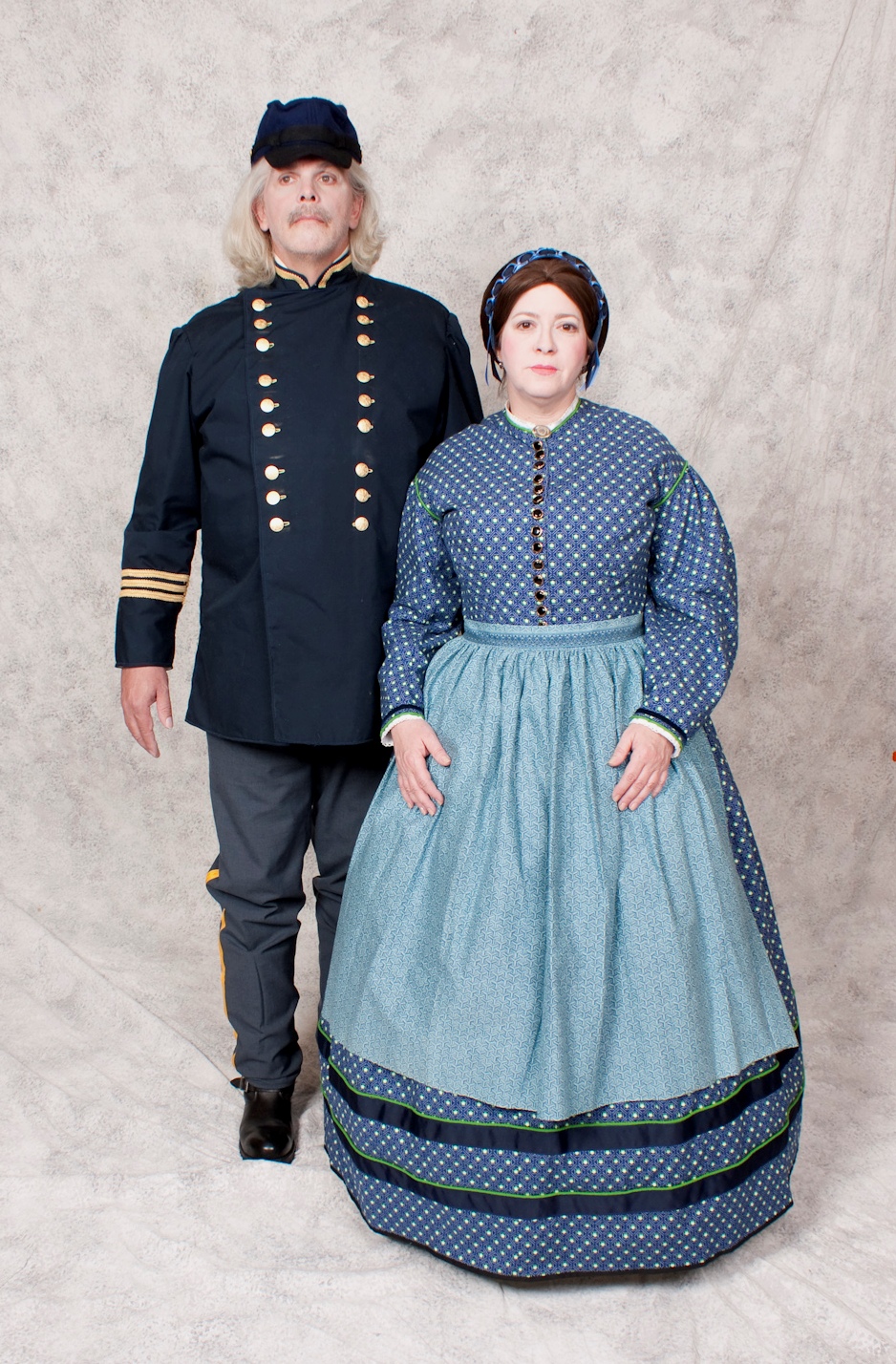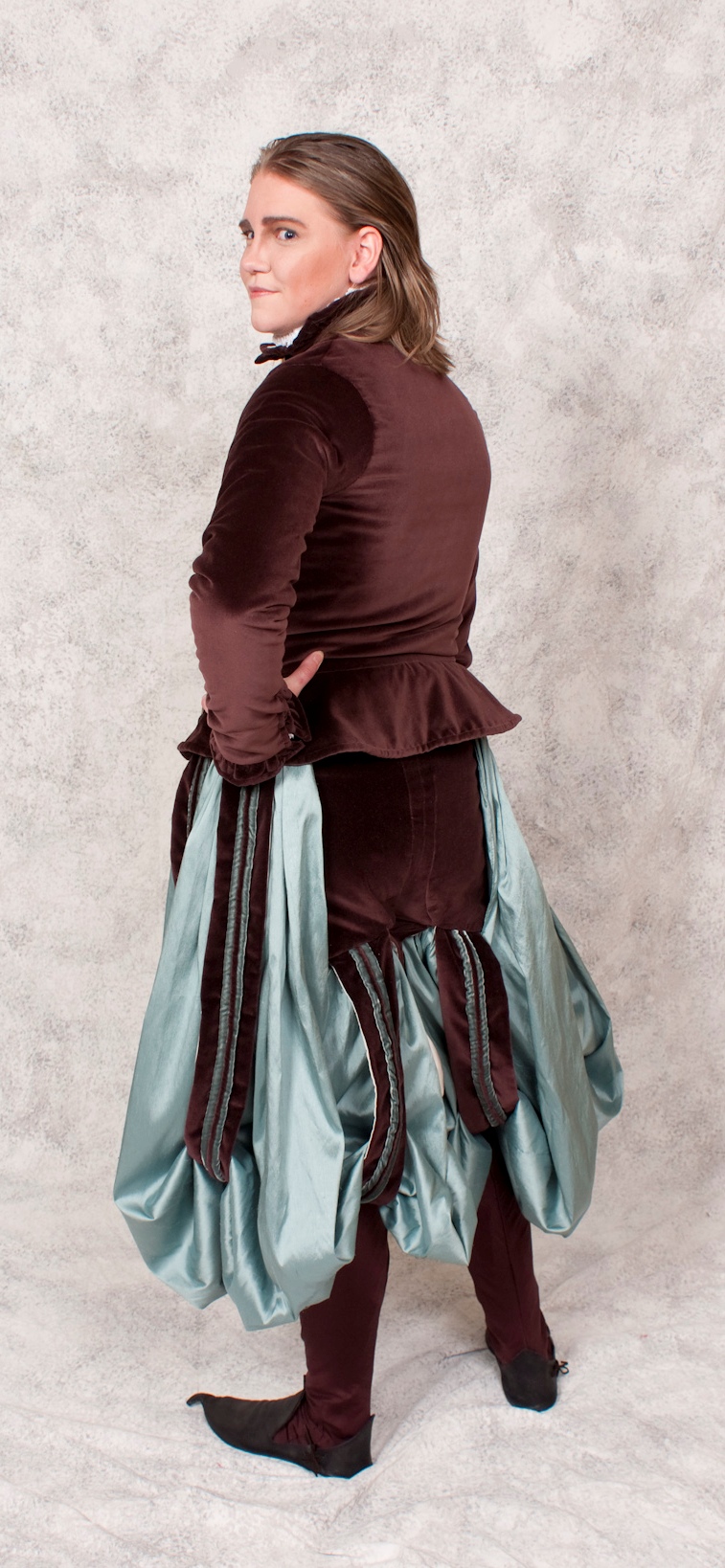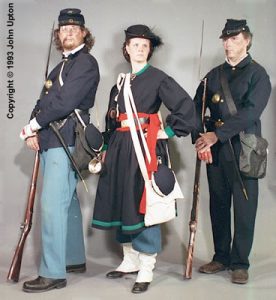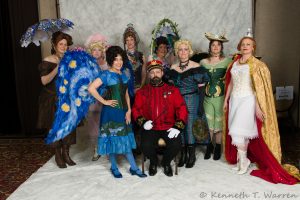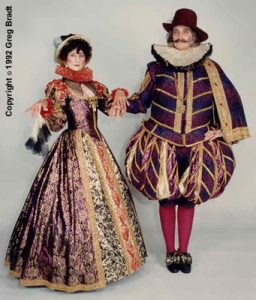CC29-H-02b: Kunst de Fashion
CC29-H-02b: Kunst de Fashion | Division: Master | Category: Historical Dress | Designer(s): Marianne Pease | Maker(s): Marianne Pease | Presenter(s): Marianne Pease | Workmanship Award(s): Best Workmanship in Show | Presentation Award(s): Best Presentation in Master Division (Photo ID: Ken Warren 20110501-3016 | Event Date: 2011)
Competition Staff & Rules
Staff:
- Director: Byron Connell
- Master of Ceremonies: Gordon Rose
- Presentation Judges: Marty Gear‡, Kevin P. Roche and Catherine Swope
- Judges’ Clerk: Judy Seidl
Rules:
The Historical Masquerade
Sunday, May 1, 2011
Byron P. Connell, Historical Masquerade Director
NEW: Gordon Rose has agreed to MC the Historical Masquerade! (January 3, 2011)
-
- The Costume-Con 29 Historical Masquerade celebrates the history of costume, including all cultures, periods, and types of dress. It recognizes creativity, scholarship, stage presentation, and workmanship skills in the context of historical clothing.
-
- “Historical costume” is costume based on clothing that was worn or could have been worn somewhere in the world through the end of December 1980.
-
- To enter the CC 29 Historical you must be a member of CC 29, as must any models you may plan to use.
-
- All entries are encouraged to should pre-register. There will be at-the-con registration, but pre-register even if you only think you’ll have a garment completed in time. Each entrant is asked to circle the appropriate date of the costume on the Registration Form (Time Period). If each costume in a group entry has a different time period, circle the appropriate dates.
- The masquerade will follow the International Costumers’ Guild Guidelines for Ensuring Fair Competition.
Competition Categories
- The Historical Masquerade will have four categories of entry:
-
-
- Theatrical Costumes
- Historical Dress,
- Historical Interpretation, and
- Ethnic Costume or Dress.
-
-
- Entries in all categories are eligible for Best in Class and Best in Show.
-
- Category Definitions.
- Theatrical Costume is for a costume or a group of costumes reproducing or interpreting costumes from the stage for productions that opened before the end of 1980. These may be from Broadway, Off-Broadway, Off-Off Broadway (etc.), or from other theatrical venues (e.g., London, the Comédie Française, regional or festival productions). However, this category is not intended for reproduction or interpretation of costumes from film or television. We plan to make special awards for entries in this category. To whet your imagination, lists of Broadway shows with Tony award winning costume designs will be posted on the CC 29 Web site.
- Historical Dress is for a costume that is intended to look like it came from a particular period of history. This includes costumes copied from a specific artwork or surviving garment, original costumes meant to look as if they were designed and made in a particular period, and everything in between. It is acceptable to use modern approximates for period materials for reasons of availability, cost, or safety; these approximations should be noted in documentation. Modern machine sewing is allowed.
- Historical Interpretation is for a costume that intentionally and visibly departs from the period on which it is based. It ought to be obvious to the viewer that this costume was not intended to be totally authentic. If the judges have to ask what makes your costume an interpretation, it probably belongs in Historical Dress.
The distinction between these two categories is based on the costume’s intent, not its execution.
- Ethnic Costume or Dress may be of any period (including the present).
Skill Levels
-
- Skill Level Definitions:
-
-
- Young Fan: This level is limited to entrants younger than 13 years of age. It will be divided between entries made by a young fan and entries made by an adult that a young fan presents.
-
-
-
- Novice: The Novice level is to encourage beginners. You may not enter at the Novice level if you (1) have won two awards at the Novice level in a Costume-Con historical masquerade, (2) have won at a level higher than Novice in a Costume-Con historical masquerade, (3) compete at the Master level in science fiction and fantasy masquerades at Costume-Cons, Animé North, or World Science Fiction Conventions (ICG-recognized “international-level competitions”), (4) have a costume Laurel, or (5) are a professional. Professional is defined as someone who earns a majority of his or her income from fashion or costume, including college or university faculty members.
-
-
-
- Journeyman: The Journeyman level is an intermediate level to allow further development of costuming skills. You may not enter at the Journeyman level if, at a Costume-Con historical masquerade, you (1) have won four awards at the Journeyman level, (2) have won an award at the Master level, (3) have won Best in Show, or (4) have a costume Laurel or (5) are a historic costume professional (as defined above).
-
-
-
- Master: This is an open level. Anyone may enter. You must enter at this level if you are not eligible to enter as a Young Fan or at the Novice or Journeyman levels.
-
-
- A contestant may enter at a level higher than the one for which he or she qualifies. However, an entrant who then wins at that level may not subsequently compete at a lower level. If in doubt over the level at which to compete, consult the Director.
Awards
-
- Our judges will make awards in three areas: A. Documentation, B. Workmanship and Detail, and C. Stage Presentation. In each area, Theatrical Costume is a separate entry category. Entries will be judged against what the judges see as the award-winning standard. This means that you will not be competing against anyone else. The judges are not obliged to award Best in Class or Best in Show if, in their opinion, no entry meets the standards for those awards.
-
-
- Documentation: Every entry must have some documentation. Documentation must be turned in to the masquerade registration desk by 8:00 p.m., April 29, 2011. If you are arriving at the con later, please contact me well in advance.
-
- Basic Documentation. The basic requirements include:
-
-
- Title of costume
- Entry category
- Name and address of the person responsible for the entry (or spokesperson for a group)
- Name(s) of designer(s) and maker(s)
- Brief identifying description of the costume’s historical period, geographic origin, social class, and so forth
- Bibliography of sources
-
The “brief identifying description” should include evidence of the historical basis for the costume. This could be as little as one photocopy of a single picture with an identifying caption or it could be more comprehensive. Assume that the judges are not familiar with the costume(s). You may wish to begin with a brief statement of what you are trying to accomplish and your rationale for choosing the project.
-
- Advanced Documentation. In going beyond the minimal requirements, your documentation might include the following:
-
-
- Pattern sources
- Photocopies of visual sources, such as artworks, costume drawings, and sketches, that you used
- Rationale for design and for choices of fabrics and colors
- Swatches of fabric and trim
- Your own photograph(s) of original historical garments or accessories
- Brief descriptions of any special skills or tools you used, such as shoemaking, weaving, or welding
-
-
- Good Documentation (Basic or Advanced). Outstanding documentation demonstrates a comprehensive knowledge of the historical source(s) on which a costume is based, with rationales for all elements of the costume, including undergarments, accessories, and minor details, and explanations for deviations from the norm of the period. Excellent documentation also is organized logically and neatly, and presented attractively. Some contestants even go to the length of designing documentation in a style consistent with the costume.
-
- Length of Documentation. Outstanding documentation is brief – long enough but no longer than you need to demonstrate the historical basis of the costume. Please be concise. Text (exclusive of bibliography and captions on illustrations) is limited to no more than five 8½”x11” typed double-spaced pages per costume. (In a group entry, each costume may have up to five pages of text.) There is no page limit on captioned photographs and illustrations, fabric swatches or other samples, references, or bibliography.
- The following will not be accepted as a part of documentation: original sources, including books and paintings (make copies), slides, computer files, and videos (tape/CD/DVD).
-
- Documentation: Every entry must have some documentation. Documentation must be turned in to the masquerade registration desk by 8:00 p.m., April 29, 2011. If you are arriving at the con later, please contact me well in advance.
-
-
-
- Workmanship and Detail Judging (“Pre-judging”): This is your opportunity to let the judges admire your work up close. Each entry will meet by itself with the panel of judges to show off the costume. Entrants will be expected to show the judges all necessary parts of the costume. If there is an item or element of the costume you want the judges to note especially, be prepared to point it out to them. We recommend that you bring the costume to the prejudging, rather than wear it, so that the judges may handle and examine your work inside and out. However, if you decide to wear the costume to prejudging, be prepared to have the judges look down your cleavage, under your skirt, or at your underwear.
-
-
-
- This part of the competition is
-
required of all entrants
-
-
- . Prejudging time will be strictly limited. While we will not know what the time limit will be until the con, it probably will be about five minutes and certainly no more than ten minutes per person. The schedule will depend on the number of entries received by close of registration. Contestants will have an opportunity to sign up in advance at the masquerade registration desk for appointments with the judges.
-
-
- Stage Presentation: Here is your opportunity to complete your illusion before an appreciative audience. Entries with one to six persons will be limited to a maximum of 60 seconds on stage. Entries with seven or more persons will be allowed up to 90 seconds. Please keep in mind that these are maximum, not minimum, lengths of presentation. If you feel that the maximum allowed will not be enough time to show your presentation, the Masquerade Director will be willing to listen to your argument and possibly allow more time, but that is in his discretion. The Masquerade Director strongly believes in brief presentations – 30 seconds normally should be sufficient to present a one-person entry to the judges and the audience.
Constraints on Presentations
All the general stage presentation rules for Costume-Con 29 masquerades will apply.
Each contestant may appear only once on stage. You may enter another costume, but it must be on another body.
The masquerade is rated PG-13; there may be children in the audience. No flagrant nudity — there must be some display of skill in creating and executing a design. The Judges will not award what Mother Nature created. Remember, no costume is no costume.
Safety is our paramount concern. There will be absolutely no flame, fires, sparks, or other flaming on stage. Other special effects must be clearly described to the Masquerade Director and to the stage manager and tech crew at the tech rehearsal in order for us to determine that they are (1) legal and (2) safe. Strobe lighting, for example, has the potential to be harmful to members of the audience. Smoke or fog machines could set off the fire alarms.
If your entry includes displaying a weapon, the Masquerade Director must clear it ahead of time in order to ascertain that it will not harm other entrants, the judges, or the audience. No sharp edges or points will be permitted. Weapons that shoot or eject projectiles will not be permitted. If you intend to point a weapon at other members of your entry or at the judges and audience, you must demonstrate in advance to the Masquerade Director that the weapon DOES NOT WORK.
Entrants may not throw anything at the audience.
We discourage the use of radio controlled or other wireless devices as part of an entry. We do not know what sort of interference will exist in the hall during the show. It would be unfortunate to base your entry on something that doesn’t work when you are on stage.
No live animals (other than guide animals) may be used in the masquerade.
Entrants may not use substances, including make-up or costume elements, that could turn rancid or be smeared on or stain other costumes. All parts of your costumes must leave with you. This is generally known as the “No Peanut Butter” rule.
Costumes with electric power requirements must be self-contained – no extension cords.
Small children must be under the control of a responsible adult at all times (back stage as well as on stage).
No purchased or rented costumes may be shown in the masquerade.
Costumes which have won major awards (excluding Honorable Mention) for presentation or workmanship at previous Animé North, Costume-Con, or Worldcon competitions are ineligible to compete for an award, but may appear out-of-competition.
Your costume must be completed before you get to the Green Room. No sewing, gluing, soldering, welding, or other construction work may take place in the Green Room except the final assembly of large costumes and props or unexpected repairs.
Music and/or narration or dialogue as part of your presentation must be pre-recorded (except for a script to be read by the MC). Provide your recordings on CD or CD-R (not CD-RW), or as a file on a USB drive. We cannot accept tape cassettes. Two copies must be handed in at the masquerade registration desk as early as possible so that the tech crew can program sound for the show. The copies should contain only the music and/or speech you want played AND NOTHING ELSE; please do not provide a commercial CD and ask us to play a specific band. We strongly recommend that you bring several copies of your recording, to provide a back-up should one fail. We also suggest bringing copies in more than one medium (e.g., a CD to back up a USB drive), just in case. Label your recordings with the entry title and your name. We do not plan to return them after the show, so please do not turn in anything of continuing value.
There will be no microphones available to entrants; the only person permitted to speak from the stage is the MC. The MC will be happy to work with you in reading a short script or to interact with you during your presentation; remember, however, that you have only one minute on stage. The MC will have only a small light on the podium under which to read scripts. Please provide your script in black double-spaced type on white paper using at least 18-point letters in a plain and easy-to-read font. Put the title of your entry and your name at the top of the script. Please keep a script for the MC to no more than about 100 words.
Following a presentation, the entrant(s), roadies, or ninjas must remove props left on stage in a single pass.
Entrants will be required to attend a tech rehearsal. This is an opportunity for the stage manager and the tech crew to work with you to assure that sound and lighting support your presentation. Entrants need not wear costumes for the tech rehearsal; however, you should wear the shoes you will use for your presentation and any parts of your costume that will impede your movement or vision, or both. Please bring a part of the costume that represents its dominant color(s) for a lighting check.
The default lighting (“Fred”) will be stage dark, lights rise on entry, fade to black at exit; other patterns may be arranged with tech.
Come to the masquerade green room when it opens officially (probably two hours before curtain time). Check in with the person at the check-in table. You will learn your number in the running order and will be assigned to a den of entries just before and/or after you, where you will be in the care of a Den Mom. Go to your den, introduce yourself to the Den Mom assigned to you, and take a seat. Please stay there until it is time to go on stage.
If you need anything, let the Den Mom assigned to you know. We plan to provide light refreshments and to have manned repair table should a costume need repairs. The repair table provides glue, safety pins, needles and thread, tools, and so forth. It is for last-minute repairs, not for building or completing a costume.
Your Den Mom will see that your photo is taken by the official masquerade photographer and the photographer taking reference photos for the judges. We expect that official photos will be available for purchase by you and other convention members, possibly the next day. Your Den Mom also will get you to the stage at the right time and in the correct order.
The Green Room and back stage area are intended for entrants, roadies, and masquerade staff only. Entrants are asked not to invite other friends or family into the Green Room.
Back stage, there will be stage “ninjas” (dressed in black) at the wings to help you up and down the stairs, move props on and off stage, and catch you if you stumble. You need to let us know how much assistance you need, especially if your vision is obscured by a mask or by not wearing your glasses, or if your costume limits your range of movement. The more assistance you need, the earlier you should let us know (preferably at the masquerade registration desk).
There also will be stage ninjas at the front and sides of the stage to try to stop you from stepping off the stage by mistake. If you hear someone shout “Stop!” during your presentation, do so; you are in immediate danger of falling off the stage! However, if you dance, run, hop, skip, or jump so fast that the catchers cannot stop you, you are responsible for your own safety.
The Masquerade Director has the full authority to eliminate anyone from the competition on the grounds of bad taste, danger to self and/or others, violation of the above rules, or any other reason deemed sufficient. There is no appeal. Offers of cash and/or chocolate will not help.
It’s good to surprise the audience; NEVER surprise the Masquerade Crew! Entrants who attempt to do so will be disqualified. If you are planning something unusual or unique, please inform the Masquerade Director well in advance of the masquerade.
If you feel any or all of these rules don’t apply to you, you are wrong. You must convince the Masquerade Director to make an exception long before the masquerade. Offers of cash and/or chocolate will not help here either.
If you have any further questions, please send an email to Historical Masquerade Director, Byron Connell.
